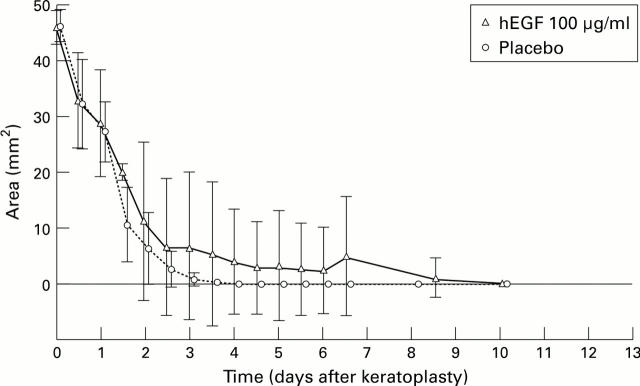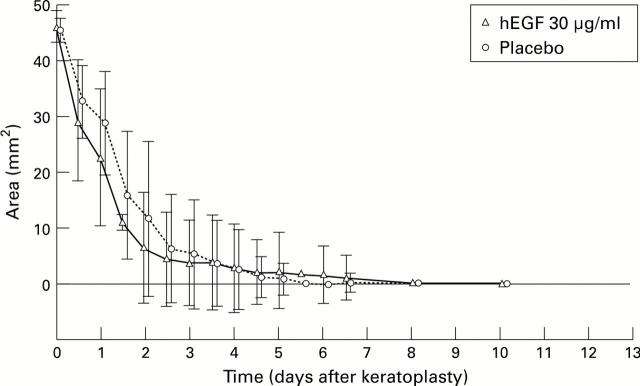Abstract
AIM—To test the efficacy and safety of recombinant human epidermal growth factor (hEGF) on corneal re-epithelialisation following penetrating keratoplasty. METHODS—A prospective, randomised, placebo controlled study was carried out in which patients were matched for diagnosis and received either hEGF ophthalmic solution (30 µg/ml or 100 µg/ml) or placebo in a double masked fashion. Matched pairs of patients received donor corneas from the same donor and were operated by the same surgeon on the same day. At the end of surgery all donor epithelium was removed mechanically. Patients were examined twice daily and fluorescein stained photographs were taken until the epithelium had closed. The area of the defect was measured by planimetry of the fluorescein stained defect on the photographs. RESULTS—There were no significant differences in re-epithelialisation of the donor cornea between the placebo group and the group treated with 30 µg/ml hEGF. Time until complete closure was slightly longer with 100 µg/ml hEGF compared with 30 µg/ml hEGF and with placebo. Mean healing rate of the epithelial defect with 100 µg/ml hEGF was significantly slower than in the other groups. CONCLUSION—No significant acceleration of corneal re-epithelialisation was demonstrated with the use of recombinant hEGF after penetrating keratoplasty in humans.
Full Text
The Full Text of this article is available as a PDF (99.2 KB).
Figure 1 .
Change in area of epithelial defect with time after penetrating keratoplasty. Size of defect at day 0 was the size of the recipient bed. Each point represents the mean (SD); area of epithelial defect was estimated by planimetry.
Figure 2 .
Change in area of epithelial defect with time after penetrating keratoplasty. Size of defect at day 0 was the size of the recipient bed. Each point represents the mean (SD); area of epithelial defect was estimated by planimetry.
Selected References
These references are in PubMed. This may not be the complete list of references from this article.
- Brightwell J. R., Riddle S. L., Eiferman R. A., Valenzuela P., Barr P. J., Merryweather J. P., Schultz G. S. Biosynthetic human EGF accelerates healing of Neodecadron-treated primate corneas. Invest Ophthalmol Vis Sci. 1985 Jan;26(1):105–110. [PubMed] [Google Scholar]
- Calel B., Fagerholm P. Human epidermal growth factor--the influence on the healing of surgically closed corneal wounds. Acta Ophthalmol Suppl. 1987;182:58–61. doi: 10.1111/j.1755-3768.1987.tb02592.x. [DOI] [PubMed] [Google Scholar]
- Daniele S., Frati L., Fiore C., Santoni G. The effect of the epidermal growth factor (EGF) on the corneal epithelium in humans. Albrecht Von Graefes Arch Klin Exp Ophthalmol. 1979 May 7;210(3):159–165. doi: 10.1007/BF00414564. [DOI] [PubMed] [Google Scholar]
- Frati L., Daniele S., Delogu A., Covelli I. Selective binding of the epidermal growth factor and its specific effects on the epithelial cells of the cornea. Exp Eye Res. 1972 Sep;14(2):135–141. doi: 10.1016/0014-4835(72)90059-0. [DOI] [PubMed] [Google Scholar]
- Ho P. C., Davis W. H., Elliott J. H., Cohen S. Kinetics of corneal epithelial regeneration and epidermal growth factor. Invest Ophthalmol. 1974 Oct;13(10):804–809. [PubMed] [Google Scholar]
- Ho P. C., Elliott J. H. Kinetics of corneal epithelial regeneration. II. Epidermal growth factor and topical corticosteroids. Invest Ophthalmol. 1975 Aug;14(8):630–633. [PubMed] [Google Scholar]
- Jenkins C. D., McDonnell P. J., Spalton D. J. Randomised single blind trial to compare the toxicity of subconjunctival gentamicin and cefuroxime in cataract surgery. Br J Ophthalmol. 1990 Dec;74(12):734–738. doi: 10.1136/bjo.74.12.734. [DOI] [PMC free article] [PubMed] [Google Scholar]
- Kandarakis A. S., Page C., Kaufman H. E. The effect of epidermal growth factor on epithelial healing after penetrating keratoplasty in human eyes. Am J Ophthalmol. 1984 Oct 15;98(4):411–415. doi: 10.1016/0002-9394(84)90121-1. [DOI] [PubMed] [Google Scholar]
- Leibowitz H. M., Morello S., Jr, Stern M., Kupferman A. Effect of topically administered epidermal growth factor on corneal wound strength. Arch Ophthalmol. 1990 May;108(5):734–737. doi: 10.1001/archopht.1990.01070070120048. [DOI] [PubMed] [Google Scholar]
- Ohashi Y., Motokura M., Kinoshita Y., Mano T., Watanabe H., Kinoshita S., Manabe R., Oshiden K., Yanaihara C. Presence of epidermal growth factor in human tears. Invest Ophthalmol Vis Sci. 1989 Aug;30(8):1879–1882. [PubMed] [Google Scholar]
- Savage C. R., Jr, Cohen S. Proliferation of corneal epithelium induced by epidermal growth factor. Exp Eye Res. 1973 Mar;15(3):361–366. doi: 10.1016/0014-4835(73)90151-6. [DOI] [PubMed] [Google Scholar]
- Sheardown H., Wedge C., Chou L., Apel R., Rootman D. S., Cheng Y. L. Continuous epidermal growth factor delivery in corneal epithelial wound healing. Invest Ophthalmol Vis Sci. 1993 Dec;34(13):3593–3600. [PubMed] [Google Scholar]
- Singh G., Foster C. S. Epidermal growth factor in alkali-burned corneal epithelial wound healing. Am J Ophthalmol. 1987 Jun 15;103(6):802–807. doi: 10.1016/s0002-9394(14)74397-1. [DOI] [PubMed] [Google Scholar]
- Srinivasan B. D., Kulkarni P. S. The effect of steroidal and nonsteroidal anti-inflammatory agents on corneal re-epithelialization. Invest Ophthalmol Vis Sci. 1981 May;20(5):688–691. [PubMed] [Google Scholar]
- Stern G. A., Schemmer G. B., Farber R. D., Gorovoy M. S. Effect of topical antibiotic solutions on corneal epithelial wound healing. Arch Ophthalmol. 1983 Apr;101(4):644–647. doi: 10.1001/archopht.1983.01040010644025. [DOI] [PubMed] [Google Scholar]
- Tripathi R. C., Raja S. C., Tripathi B. J. Prospects for epidermal growth factor in the management of corneal disorders. Surv Ophthalmol. 1990 May-Jun;34(6):457–462. doi: 10.1016/0039-6257(90)90127-h. [DOI] [PubMed] [Google Scholar]
- Urdea M. S., Merryweather J. P., Mullenbach G. T., Coit D., Heberlein U., Valenzuela P., Barr P. J. Chemical synthesis of a gene for human epidermal growth factor urogastrone and its expression in yeast. Proc Natl Acad Sci U S A. 1983 Dec;80(24):7461–7465. doi: 10.1073/pnas.80.24.7461. [DOI] [PMC free article] [PubMed] [Google Scholar]
- Watanabe K., Nakagawa S., Nishida T. Stimulatory effects of fibronectin and EGF on migration of corneal epithelial cells. Invest Ophthalmol Vis Sci. 1987 Feb;28(2):205–211. [PubMed] [Google Scholar]
- Woost P. G., Brightwell J., Eiferman R. A., Schultz G. S. Effect of growth factors with dexamethasone on healing of rabbit corneal stromal incisions. Exp Eye Res. 1985 Jan;40(1):47–60. doi: 10.1016/0014-4835(85)90107-1. [DOI] [PubMed] [Google Scholar]
- van Setten G. B., Tervo T., Viinikka L., Pesonen K., Perheentupa J., Tarkkanen A. Ocular disease leads to decreased concentrations of epidermal growth factor in the tear fluid. Curr Eye Res. 1991 Jun;10(6):523–527. doi: 10.3109/02713689109001760. [DOI] [PubMed] [Google Scholar]
- van Setten G. B., Viinikka L., Tervo T., Pesonen K., Tarkkanen A., Perheentupa J. Epidermal growth factor is a constant component of normal human tear fluid. Graefes Arch Clin Exp Ophthalmol. 1989;227(2):184–187. doi: 10.1007/BF02169794. [DOI] [PubMed] [Google Scholar]




